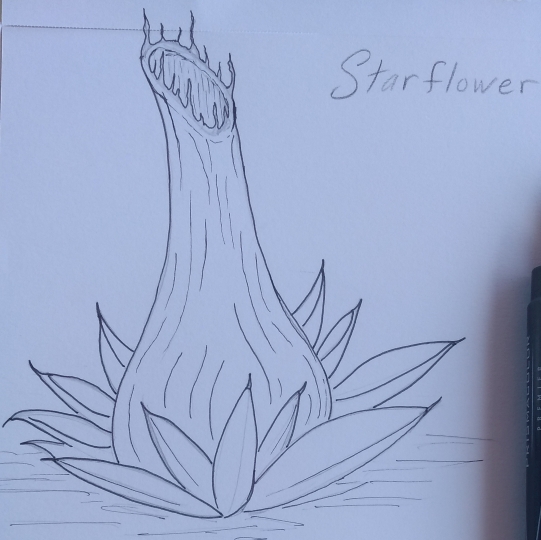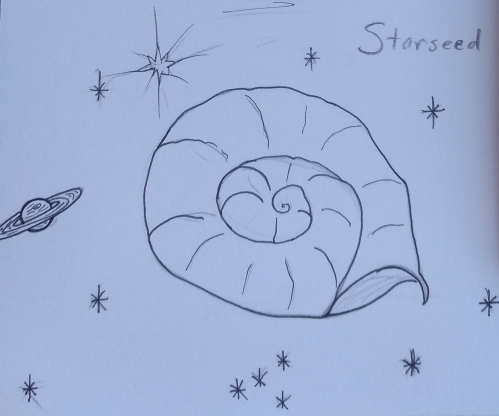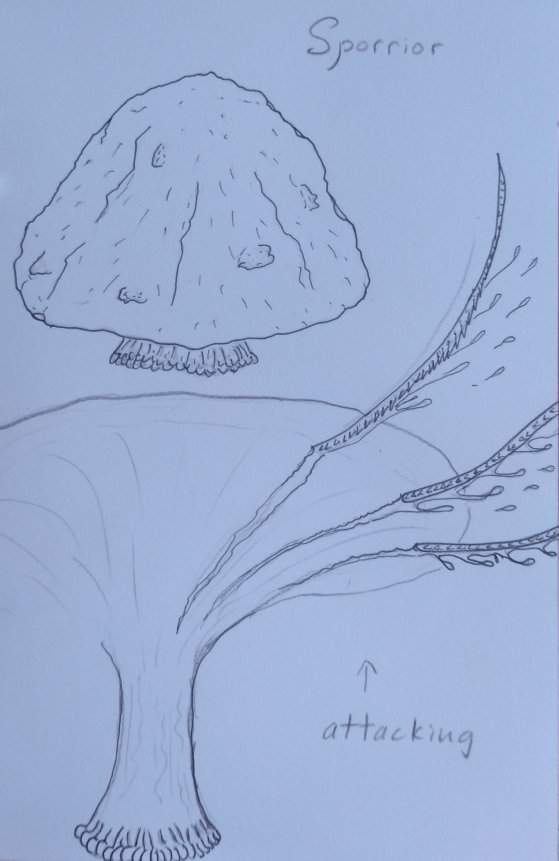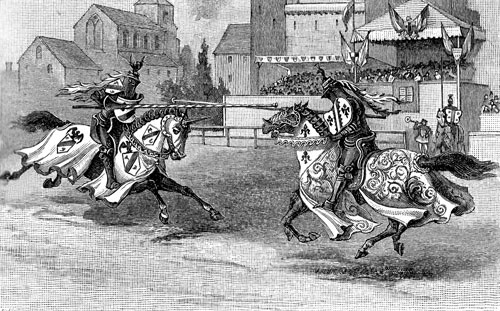Starseeds and Sporriors
These spacefaring fungal creatures have a complex polymorphic lifecycle. Although mindless, they are a dangerous invasive species.
In all of their stages they grow by externally digesting organic or chemically useful compounds and minerals, and also through a photosysthisys-like process that allows them to slowly grow even in the wan starlight of deep space. This process and the mineral-like composition of their outer skins even allows them to grow from the energy of pulsars, gamma streams, and radioactive materials like uranium oxide deposits or atomic warheads.
Their cyclical lifecycle proceeds as follows: from tiny Spores grow Starflowers, which will grow as slow or as fast as local conditions allow. Their color varies depending on the local available nutrients, minerals, and radiation. Their bulb-based, tubular flowers grow until they are large enough to form a Starseed for the journey into space.

At that point the Starflower explosively launches the Starseed into the night sky, using the delicate fronds at the top to sense nearby stellar bodies for its progeny. The Starflower is blown into pieces by this process, which begins a cycle of regrowth. In being destroyed, the Starflower releases its internal defenders and the re-seeders of the flower: the Sporriors. Waiting encased in the Starflowers flesh are the nascent, ambulatory guardians who spread the Spores wherever they go. The destroyed Starflower’s remains become fertile ground for a new, wider batch of Starflowers, and the process continues.
Starflowers sometimes explode when cut or struck, depending on their state of growth.
If the Starseed escapes the local gravitational body, and makes it into space, and it doesn’t end up in a sun, it will break open upon impact, releasing Sporriors from their layered interiors and providing organic material for their new Spores to grow upon. If the Starseed doesn’t make it to space, when it falls back down it breaks open and seeds a new area.

In the asteroid fields and on the tiny iceballs in the depths of dim interstellar space the Starflowers grow slowly and are only large enough to launch little starseeds away from their host body. They release tiny little Sporriors to slowly crawl around spreading new Starflowers.
On planets like Earth with rich local organic deposits, a warm nearby star, and 1G local gravity, the Starflowers will quickly grow to be 90 meters tall or taller before exploding, which launches Starseeds measuring 10-15 meters in diameter. At that size the conical, ambulatory Sporriors released when damaged are 2-3 meters (6-9 feet) tall and in circumference at the bottom of their caps.
Slow but steady walkers, Sporriors spill out from damaged Starflowers and Starseeds, and mill about spreading Spores. They can also climb quite well owing to the hundreds of tiny appendages on the bottom of their trunks. They move very quietly, which combined with their rocky-looking exteriors makes them stealthy.
As they move the Sporriors slowly drip spores suspended in digestive acids, which will grow into Starflowers.
Though lacking a central nervous system or language, they will quietly and steadily walk towards any sound or vibration they sense. And if their tough outer cap touches anything that is moving for more than a moment, be it a sapling or a curious child, they attack.
A hydraulic and chemical reaction causes their conical caps to flip up, inverting. This causes the burning sporewhips, which line the interior of the cap, to fling out in all directions around the Sporrior to a distance of 2-3 meters. The burning sporewhips lie in channels of digestive juices and Spores, and are raspy, so they cut, chemically burn, and possibly infect anything they hit. This reflexive attack also momentarily exposes the Sporriros softer inner cap and stalk.
Sporrior
large fungal plant
Armor Class: 16 (or 9 when attacking)
Hit Points: 48 (4d8+16)
Skills: Stealth +4
Move: 10′, climb 5′
Attack: +4 attack against all creatures within 10 feet / 3 meters, damage 1d4 + 2 slashing, 1d3 acid, and DC 12 Constitution Saving Throw or become infected with burning, itching, tiny-Sporeflower-growing spores. Unless treated with healing magic, technology, or DC 12 Medicine skill checks, the digesting spores will eat away at the infected creature’s body, spreading and dealing 1d12 Hit Points of damage per day.
Challenge Rating: 1

Posted in 3rd edition Dungeons & Dragons / d20 fantasy / Pathfinder, 5th edition Dungeons & Dragons, Creature, d20 Future, D20 Modern, Gamma World, Post-Apocalyptic, Science-Fiction and tagged alien, fungus by Adam A. Thompson with no comments yet.
The zone ghouls cry out, “Glob bloessss the wastelands!”
#NSFW #puppets #apocalypse #robot #mutant
Posted in d20 Future, Fiction, Gamma World, Post-Apocalyptic and tagged #NSFW #puppets #apocalypse #robot #mutant by Adam A. Thompson with no comments yet.
5th edition Dungeons & Dragons Combat Critical Fumble Rules
I like critical fumbles in my D&D game. They increase randomness, speed up combat, and create tension and chaos on the battlefield. For me it’s a significant part of the fun of the game, so I use a critical fumble rule for combat when I’m the Dungeon Master or Referee.
So here’s my house rule: when someone rolls a 1 on an attack roll, they have to roll a d20 again to see how bad the fumble is:
20 – Recovery – the fumble has no major ill effect (feel free to make up some comical reason why)
16-19 – Over-swing – disadvantage on fumbler’s next attack roll
12-15 – Miss-step – advantage on the next attack against fumbler
9-12 – Fall Down – fumbler falls prone
5-8 – Drop Weapon – fumbler drops weapon, or else is dazed next round
4-2 – Wild Swing – attack self or ally (attacking player makes new attack roll)
1 – The Gods Frown – attack self or ally with advantage (attacking player makes new attack rolls), or something equally disastrous
The basic idea is, if you roll a 1, something bad happens. Not only have you failed, but your situation has gotten worse somehow.

I used to use a different simple critical fumble table, where the results were basically a d4, and the lower you rolled the worse it was. I like it because it’s easy to memorize and use without having to refer to a table.
The above table is expanded to use the full numerical granularity of a d20. It also uses the “rolling 20 is good, rolling 1 is bad” game design element.
D4 Fumble Table
4 – off balance – enemies have advantage to attack you next round
3 – fall down – fall prone
2 – drop weapon – drop weapon or are dazed next round
1 – bad swing – attack self or ally
There have been a lot of critical fumble rules published, but recently I’ve seen a fun idea about how to handle fumbles. On the Moisture Farmer’s podcast, I heard them using a new-to-me critical fumble rule. Not only is it great for it’s simplicity, but also for the opportunity to be creative.
If a player rolls a 1, the GameMaster decides what happens to the player’s character. When a GameMaster rolls a 1, the players decide what happens to the GameMaster’s character. So when the GM fumbles, the players get to narrate what happens. When a player fumbles, the GM gets to narrate it.
No boundaries are needed, but as a DM, I’d probably usually limit to to, at worst, damaging your own character or an ally. If the players always end up demanding the the monsters fall on their swords and die, then it would be reasonable for the DM to decide the same thing happened to the PCs. So there’s an opportunity to do some creative role-playing and cooperate to keep things “in bounds”.
Do you use critical fumbles in your game? Why or why not? Let us know in the comments below.
Posted in 5th edition Dungeons & Dragons, d20 Future, D20 Modern, Gamma World, Uncategorized, Variant Rules and tagged critical fumble by Adam A. Thompson with no comments yet.
Watcher
 The Watchers are a race of bio-mechanical floating orbs of flesh and metal with camera lenses as their corneas, a large central eye that is always turned toward to their prey. The center eye provides levitation and other basic cognitive functions.
The Watchers are a race of bio-mechanical floating orbs of flesh and metal with camera lenses as their corneas, a large central eye that is always turned toward to their prey. The center eye provides levitation and other basic cognitive functions.
In addition to the large central eye, Watchers have 8 retractable compartments containing foot-long extensions that appear long enough to cause their effects before retracting back into the metallic carapace of the Watcher. Four of these extensions are standard to all Watchers, and 4 with special powers based on the type of Watcher. Each power recharges 4 rounds after use, and each Watcher can use 2 extensions each round (3 if they do not move):
- Telekinesis: objects up to 300 lbs.
- Lightning Bolt: 3d6 to all in a line, bouncing off conductive surfaces, DC 25 reflex for half damage
- Stun Ray: stuns target for 1d4 rounds, +15, DC 25 fortitude to halve (min 1)
- Fear: DC 25 will save negates, cower in fear for 1d4 rounds
- 4 specific to the type of Watcher
This eye is a gem (the types vary by Watcher) worth 10,000 credits. Any damage dealt to the Watcher in 20 or more points (after the DR/10) in a single strike disables one of the 8 extensions. Roll 1d8 to determine which, rerolling any results that correspond with extensions which are already disabled.
In addition, a simplified humanoid brain is used to power the Watcher. Some of these come directly from humans, while others are synthesized via artificial means. These brains are programmed like computers, allowing the Watchers to be provided commands that govern their abilities, granting them semi-sentience.
Other stats of interest:
Init: +6 Senses: darkvision 60’ Listen -2 Spot +25
Languages: Telepathy 60’ and either common or none
AC: 26 (-1 size, +3 dex, +14 natural)
HP: 130 (12d12+44)
Defenses: SR 20, DR 10 / psychic
Saves: Fort: +9 Ref: +7 Will: +11
Speed: fly 30 ft.
Attack: Lightning Touch +9 ranged touch and bite +7 melee (2d4), various extensions
Full Attack: Lightning Touch +9 ranged touch and bite +7 melee (2d4), various extensions
Attack Options: Lightning Touch, Spell-like effects
Space / Reach: 10ft. / 5ft.
Base Attack: +8 Grapple: +12
SQ: DR 10/psychic, SR 20, All-around vision, Flight
SA: spell like abilities: Blur
Feats: Alertness, Flyby Attack, Great Fortitude, Quicken Spell-Like Ability (Blur)
Abilities: Str 11 Dex 16 Con 18 Int 16 Wis 14 Cha 15
Skills: Hide +12, Knowledge (arcana) +14, Knowledge (planes) +8, Search +18, Spot +25, Survival +6
Spell-like abilities: 1/day – blur (caster level 13)
DR: 10/good
Spell Resistance: 20
There are several varieties of Watchers, four of which are detailed here.
Reflect Watcher
- Mirror Image: Reflects 50% of attacks back on attacker
- Pass Through Glass: Can pass through reflective surfaces
- Force Shield: 20’, similar to a wall of force. Impassable, except via telekinesis and shadow dancing.
- Laser Light: 1d6+1 and target must succeed on a DC 25 reflex save or be blinded for 1d4 rounds.
Holo Watcher
- Ghosting: All attackers have a 50% miss chance. Hits occur against the inner hull, which is considerably smaller than the appearance of the holo watcher.
- Illusions: Projects illusions every round (disbelieve on DC 25 will save). Favored illusions include doorways and passageways that appear to open along the walls, pits that lead the target to them, as well as spurious letters and numbers and obscuring the actual letters on walls, doors, etc.
- Spotlight: Target must succeed on a DC 25 reflex save or be blinded for 1d4 rounds.
- Ghost Sound: Sounds of approaching enemies, impending doom, creaking locks, levers, doors, etc.
Striker Watcher
- True Strike: Deals 1d4 damage on an automatic hit each round (recharges every round).
- Force Push: Either a living or inanimate target 3 squares. In this case, the metal spheres can be pushed into the goals for points.
- Dive: The Watcher can shift 1 square to block a shot.
- Laser Beam: 2d8+4 damage on a successful hit (+10 with a DC 25 reflex save for half).
Defender Watchers (Minor)
- These Watchers have the same base powers of the Watchers, but only the 4 core extensions (lightning bolt does 1d6+1 to all targets in a straight line).
- 60hp, AC 23.
Shadow Watcher
- Invisibility: to those who see the visible spectrum, but visible via infrared sensing.
- Fireball: 3d6 to a 4×4 square area, DC 25 reflex for half damage.
- Darkness: as the spell, in a 20’ radius.
- True, Extra-sensory Sight: Can see all, never flat-footed.
Many more varieties exist; feel free to extend these Watchers to fit your own campaign.
Posted in Creature, d20 Future by Adam A. Thompson with no comments yet.